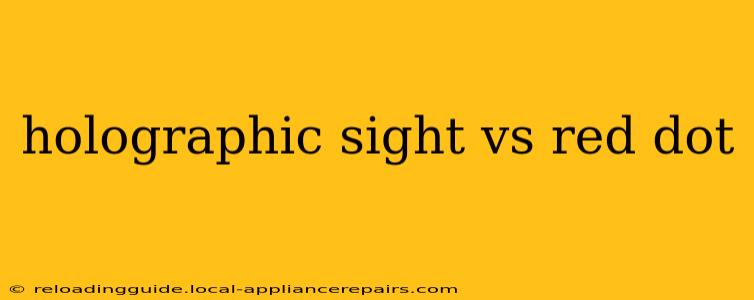Choosing between a holographic sight and a red dot sight can feel overwhelming. Both offer significant advantages over iron sights, but their differences in technology, performance, and cost impact their suitability for various applications. This in-depth comparison will help you understand the nuances of each and decide which is best for your needs.
Understanding the Technology
Both holographic and red dot sights project a aiming point onto a lens, providing a clearer and faster target acquisition than traditional iron sights. However, the methods differ significantly:
Holographic Sights
Holographic sights use a laser to project a reticle (the aiming point). This creates a truly three-dimensional image that appears to float above the optic. The image is generally sharper and brighter, especially in low-light conditions, and remains clear even at a wider range of viewing angles. The reticle itself is often more robust and durable, resisting damage better than the etched reticles found in some red dots.
Red Dot Sights
Red dot sights employ an LED that illuminates a reticle etched onto a lens. This results in a two-dimensional image that, while still superior to iron sights, can appear less distinct, especially in challenging lighting. The brightness of the dot can be adjusted, but excessive brightness can wash out the image. Furthermore, some red dots are more susceptible to parallax error (the apparent shift in the aiming point relative to the target).
Key Differences: A Head-to-Head Comparison
| Feature | Holographic Sight | Red Dot Sight |
|---|---|---|
| Reticle Type | Laser-projected, 3D, often brighter | LED-illuminated, 2D, etched reticle |
| Brightness | Generally brighter, especially in low light | Adjustable, but can wash out in bright light |
| Durability | Typically more robust | Variable, depending on the model |
| Parallax Error | Less susceptible | Can be more susceptible |
| Cost | Generally more expensive | Generally less expensive |
| Battery Life | Can vary significantly, but generally good | Variable, greatly depends on brightness setting |
| Weight | Often heavier | Often lighter |
Applications and Ideal Users
While both sight types enhance aiming accuracy, their strengths cater to different needs:
Holographic Sights: Ideal for
- Law enforcement and military: The superior brightness and durability are crucial in high-stress environments.
- Competitive shooting: The clear, sharp reticle contributes to faster target acquisition and improved precision.
- Hunters operating in low-light conditions: The brighter reticle enhances target visibility at dawn and dusk.
Red Dot Sights: Ideal for
- Budget-conscious users: Red dots offer excellent value for the price, particularly entry-level models.
- Users prioritizing lighter weight: Red dots are generally lighter than holographic sights, reducing fatigue during extended use.
- Hunters prioritizing close to mid-range accuracy: Red dots are perfectly adequate for most hunting scenarios.
Conclusion: Making the Right Choice
Ultimately, the best sight depends on individual priorities and usage. Holographic sights offer superior performance in many aspects, especially brightness and durability, but at a higher cost. Red dot sights provide a more affordable alternative with decent performance for many applications. Carefully consider the features, your budget, and your specific needs before making a decision. Reading detailed reviews of specific models from reputable sources will further assist in your choice.

